ARTICLE
Published in October 2021. Updated in November 2023.

A series of paintings inspired by Ta Chuan (The Great Treatise) and I Ching (The Book of Changes).
Barry (1939, New York) is an architect, painter and poet, mainly a self-taught artist and T'ai Chi Chuan practitioner. Inspired by the Taoist philosophy, and after meditating on Richard Wilhelm's I Ching translation, in 1993 he started to draw the 8 basic trigrams (Fu Hsi's kuas), which provide a rame to the book's ideograms. In 2005, he finally arrived to a series of paintings that may be considered as a visual system. In 2009, the series included 80 square-shaped artworks, in 42" x 42" acrylic on canvas.
Each painting displays two forms. The main one is the quantity of lines of the ideogram (1, 2, 3 or 6), which is indicated by the number of alternating colored segments across two vertical lines, on the right and left borders of the paintings.
The second form is the internal one (in between those borders), to which the artist added his own poetic elements and a very singular characteristic: all of them especially refer to yin energy (discontinous lines), which is physical openness and space.
In trigrams, discontinous lines are indicated by specific elements and shapes. In hexagrams, they're always where the background color can be seen: through circles, semi-circles, extended shapes (alike bars, gates, distorted drops), sharp vertex, rectangular lines, concav and convex extremes, several types of triangles, picks in slopes, or just irregular holes.
- The Eight Kuas
- Color Reference
- Eight hexagrams, commented
- The origin of the series
- Other BF's series
I. The eight kuas
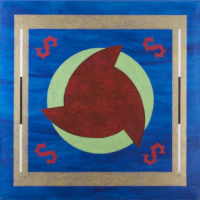
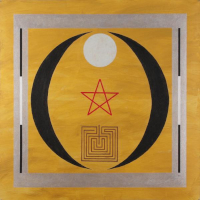




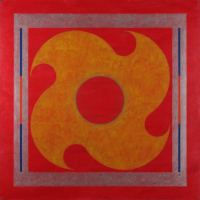

II. Color reference

reference

 Each trigram is associated to a spatial orientation in the image. You can see the color Barry assigned to each one of them. In trigrams paintings, the color of the 1st segment in vertical lines is that of the very trigram, and the 2nd segment is colored as the opposite trigram. Opposites are: N - S, E - W, NW - NE and SW - SE. In hexagrams, the color of the 1st segment is that of the lower trigram, and the 2nd segment is colored as the opposite trigram.
Each trigram is associated to a spatial orientation in the image. You can see the color Barry assigned to each one of them. In trigrams paintings, the color of the 1st segment in vertical lines is that of the very trigram, and the 2nd segment is colored as the opposite trigram. Opposites are: N - S, E - W, NW - NE and SW - SE. In hexagrams, the color of the 1st segment is that of the lower trigram, and the 2nd segment is colored as the opposite trigram.
III. Eight hexagrams, commented
 |
| |
 |
KOU. 1st line & description
It must be checked by a brake of bronze.
Perseverance brings good fortune.
If one lets it take its course, one experiences misfortune.
Even a lean pig
has it in him to rage around.
The lower semi-circle indicates the sign has one yin line, and it's the only one. The strange red figure seems to stand on two supports at the height of that line (the bases of the situation, organization or structure). If the line changes, acquiring correspondence may imply losing authority, to something or someone. Barry has drawn in Sun's background three zig-zag parallel lines representing the challenge that type of move means to the ruling order, especially if it involves someone or something just arriving or met in a superficial way.
 |
| |
 |
HSIAO CH'U. 1st line & description
Return to the way.
How could there be blame in this!
Good fortune!
An open space above the line on the blue background horizon, alike an inverted drop, indicates a discontinous line in the 4th position of the sign, and it's the only one of its kind. Other two similar figures at both sides seem to penetrate at the base, becoming waves: Sun is wind and its influence is doubled by the 1st line's change: it's much easier to be fusioned, go somewhere, towards someone, and object or situation.
 |
| |
 |
FENG. 5th line & description
Lines are coming, blessing and fame
draw near. Good fortune!
The red central figure holds within a circle with a top border like a sharp arrow (or the figure has been extracted), which allows seeing the background purple color: lines 2nd, 5th and 6th are yin. Electric background strokes at the height of the 5th line indicate the effects of the move. Expect for changes of all kinds, very hard to reject or avoid, unpleasant to our inner state, ways and relationships (although they'll bring other ways to move, distribute, express and function).
 |
| |
 |
SHIH HO. 4th line & description
Bites on dried gristly meat.
Receives metal arrows.
It furthers one to be mindful of difficulties
and to be persevering.
Good fortune!
The light blue central figure has two convex-shaped holes of straight angles that allow seeing background colors: lines 2nd, 3rd and 5th are yin. At Li's base, small sharped figures point from both sides towards the representation of the continous (yang). They, along with thunders arriving from the four corners, symbolize forces impulsing the change of the 4th yang line. The move clears out and leads to get more... previous affairs are removed and remain in the past, although something has been opened: we have to give some time and be willing to host whatever emerges out...
 |
| |
 |
LIN. 6th line & description
Greathearted aproach.
Good fortune. No blame.
An internal circle-shaped area has been extracted from the central circle, sticked to the top area. The empty space allows seeing background colors: lines 3rd to 6th are yin. Part of a big yellow sphere at the top represents the final move in the sign: a developmental cycle begins, one of progressive earning, richness and increment, all of which will be kept inside of a mountain and retained for the own usage.
 |
| |
 |
TS'UI. 3rd line & description
Gathering together amid sighs. Nothing that would go further.
Going is without blame. Slight humiliation.
Sharped vertex of the central figure create triangular areas that allow seeing the background color: lines 4th and 5th are the only yang strokes. A yellow line from one extreme to the other one at the height of the 3rd line seems a container mould for the lake, which indicates the stroke's type of move. We find limitations, it's hard to access situations or people such as we were used to before, and it would be even convenient to remember that the resources are not endless: we're going to find a path of restrictions.
 |
| |
 |
MENG. 5th line & description
Childlike folly brings good fortune.
The clear central figure has an internal hole of ogival and rounded borders, and the base is ogival the same although concav, which allows seeing the background colors: only lines 2nd and 6th are yang. There're two small light blue ovals at the height of the 5th line, as two areas opened on Ken's background, the restraining mountain. When the nucleus inside of it changes, things start getting better and restrictions decrease, finding more fluent relations that also provide energy: we can now go through persisting problems although counting on a better inner mood.
 |
| |
 |
CHIEN. 4th line & description
Going leads to obstructions,
coming leads to union.
The dark central figure holds within a vertical rectangular form at the base, a central opening and a concav ending at the top (with a spheric visual effect), all elements that allow seeing the background color: the sign has only 2 yang lines in the 3rd and 5th positions. All of the figures included at both sides, on each line, represent inadvisable moves. At the height of the 4th line, a small brown rectangle is upon and covers two extensions, as if they were two extended arms. The move is not just not removing obstacles but also reduces our extent, reach and achievements.
Even counting on a wide meditative experience and Tai Chi Chuan expertise, Barry thinks on his artworks as structured pieces, composed like a puzzle, which may be related to his architectural working activities in the past. About it, he has said:
indexGoing back to the 'Tao that can be explained is not the Tao' I don't wish my work to be explained. I wish it to be experienced
Barry Fishman 1
IV. The origin of the series
I Ching series begins with two paintings inspired by Ta Chuan: Earlier Heaven and Later Heaven. They distribute colors inside of a square-shaped design, the ones we'll see in all of the other paintings of the series. They're also the base for another later series (Heaven).

After the first ones, the series introduces other four paintings which provide the frames and border patterns. Yin adds a gray frame, whereas Yang provides a golden one. Both paintings also include a single segment on borders at both sides, whereas Greater Yin and Greater Yang are bigrams, so they display 2 segments on each border, thus setting an alternating pattern according to the number of strokes.
Visit the artist's website to know other hexagrams:
I Ching series




V. Other BF's series
Barry's artworks are in private collections but you can see other series by following any of the titles below, or just by sending him a message:
| Bagua |
| 8 trigrams. Acrylic on masonite (90" x 30"). 1993. |
| Bagua Dragon |
| 8 annual hexagrams. Acrilic on canvas (52" x 30"). 2014. |
| Dragon |
| 6 abstract Dragon's landscapes. Acrilic on lynen / canvas (min. 50" x 50"). 1992. |
| Heaven |
| 12 variations of 3 paintings each one. They represent motion from staticts towards dynamics, through a transitional painting where the third painting absorbs the first one in the nucleus. It's based on Earlier Heaven and Later Heaven of I Ching series. Acrilic on masonite (18" x 18"). |
index
1 Interview in Jung Journal ("Barry Fishman, Yin Yang and the 10,000 Things").
Sources: ETAOIN, NewArtLab: Barry Fishman's I Ching Paintings, Shao Yong.



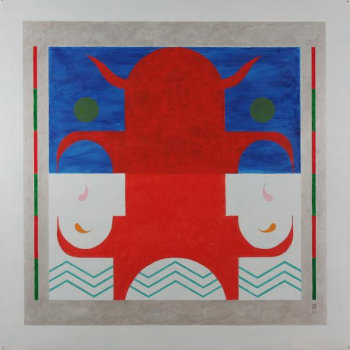

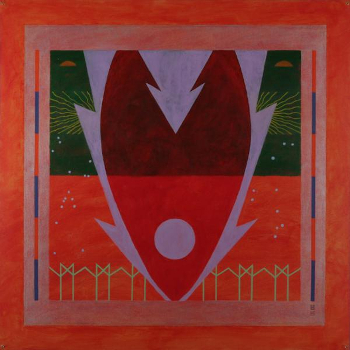




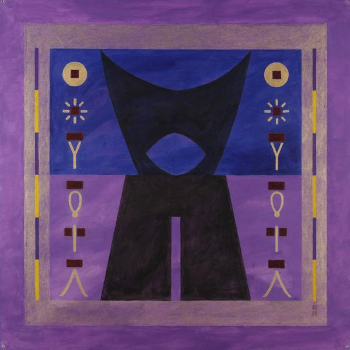


Comments
Join and leave a message. I always answer personally, and as soon as possible.